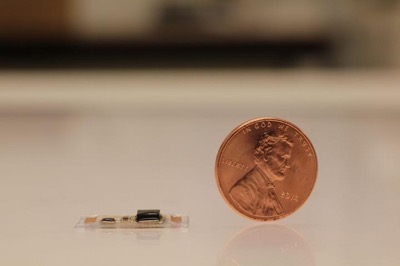CU Boulder, Northwestern researchers lead project to measure acoustical vibrations of heart, vocal cords.
UNIVERSITY OF COLORADO AT BOULDER - Researchers from the University of Colorado Boulder and Northwestern University have developed a tiny, soft and wearable acoustic sensor that measures vibrations in the human body, allowing them to monitor human heart health and recognize spoken words.

A tiny, wearable acoustic sensor developed by researchers can be used to monitor heart health and recognize spoken words. Credit: Northwestern University, University of Colorado Boulder.
The stretchable device captures physiological sound signals from the body, has physical properties well-matched with human skin and can be mounted on nearly any surface of the body, said CU Boulder Assistant Professor Jae-Woong Jeong, one of three lead study authors. The sensor, which resembles a small Band-Aid, weighs less than one-hundredth of an ounce and can gather continuous physiological data.
"This device has a very low mass density and can be used for cardiovascular monitoring, speech recognition and human-machine interfaces in daily life," said Jeong of the Department of Electrical, Computer and Energy Engineering. "It is very comfortable and convenient - you can think of it as a tiny, wearable stethoscope."
A paper on the subject was published Nov. 16 in Science Advances, a sister journal of Science. The other two co-corresponding authors are Professors Yonggang Huang and John Rogers of Northwestern.
"The thin, soft, skin-like characteristics of these advanced wearable devices provide unique capabilities for 'listening in' to the intrinsic sounds of vital organs of the body, including the lungs and heart, with important consequences in continuous monitoring of physiological health," said Rogers, the Simpson Querrey Professor of Materials Science and Engineering, Biomedical Engineering and Neurological Surgery. Rogers also is director of Northwestern's Center for Bio-Integrated Electronics.
The researchers say the new device can pick up mechanical waves that propagate through tissues and fluids in the human body due to natural physiological activity, revealing characteristic acoustical signatures of individual events. They include the opening and closing of heart valves, vibrations of the vocal cords and even movements in gastrointestinal tracts.
The sensor can also integrate electrodes that can record electrocardiogram (ECG) signals that measure the electrical activity of the heart as well electromyogram (EMG) signals that measure the electrical activity of muscles at rest and during contraction.
While the sensor was wired to an external data acquisition system for the tests, it can easily be converted into a wireless device, said Jeong. Such sensors could be of use in remote, noisy places - including battlefields - producing quiet, high-quality cardiology or speech signals that can be read in real time at distant medical facilities.
"Using the data from these sensors, a doctor at a hospital far away from a patient would be able to make a fast, accurate diagnosis," said Jeong.
Vocal cord vibration signals also could be used by the military personnel or civilians to control robots, vehicles or drones. The speech recognition capabilities of the sensor also have implications for improving communication for people suffering from speech impairments, he said.
As part of the study, the team used the device to measure cardiac acoustic responses and ECG activity -including the detection of heart murmurs - in a group of elderly volunteers at Camp Lowell Cardiology, a private medical clinic in Tucson, Arizona collaborating with the University of Arizona, a project partner. The researchers also were able to detect the acoustical signals of blood clots in a related lab experiment, said Jeong.
Other CU Boulder study co-authors on the Science Advances paper include Assistant Professor Jianliang Xiao and doctoral student Zhanan Zou of mechanical engineering and doctoral student Raza Qazi of electrical engineering.
The sticky, flexible polymer encapsulating the tiny device is stretchable enough to follow skin deformation, said study first author Yuhao Liu, who earned his doctorate and the University of Illinois-Urbana Champaign and now works at Lam Research, headquartered in Fremont, California. The device contains a tiny commercial accelerometer to measure the vibration of the body acoustics and allows for the evaporation of human sweat.
The researchers also showed vocal cord vibrations gathered when the device is on one's throat can be used to control video games and other machines. As part of the study a test subject was able to control a Pac-Man game using vocal cord vibrations for the words "up," "down," "left" and "right."
"While other skin electronics devices have been developed by researchers, what has not been demonstrated before is the mechanical-acoustic coupling of our device to the body through the skin," Jeong said. "Our goal is to make this device practical enough to use in our daily lives."
The study also included the Eulji University College of Medicine in Korea.
Source: https://www.eurekalert.org/pub_releases/2016-11/uoca-ted111416.php

